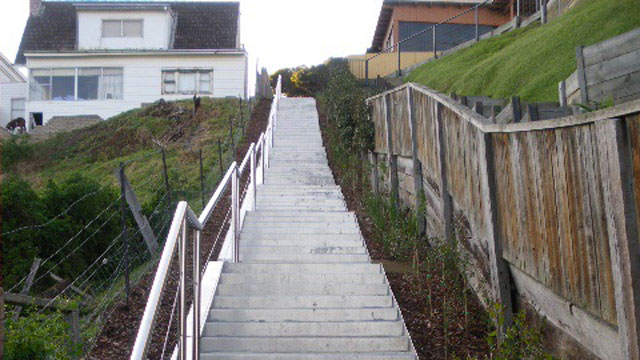Summary Of The Project
Frankston City Council, as part of its ongoing commitment to providing an Active and Healthy Community with attractive, user-friendly facilities, recognised the need to replace the current upper section steps which provide pedestrian connectivity between the Nepean Highway and Muir Street in Frankston South.
The steps had been fenced off and were not available for public use due to slippage of the staircase sections / landings and the overall poor condition of the stair flight units and handrails.
Description Of Project
Project Objectives
Through the completion of this project residents and visitors will have greatly improved access to Muir Street and Nepean Highway via the Nepean Lane stairs. This will open up the Frankston Waterfront to more pedestrians from the Frankston South area.
Project Outcomes
Council has re-opened the laneway so that residents and visitors can now once again access the Frankston Waterfront from Cliff Road.
Materials needed to have longevity in a corrosive coastal surrounding and be able to withstand any ground movement or slippage due to the steepness of the laneway.
Innovative features of the project
It is envisaged that the concept and design principals used during this project may be adapted to many more of Frankston City Councils parks and recreations stairs.
The stair cases were manufactured off site and were able to be manually carried down the steep slope. This was critically important in overcoming difficult site and access conditions. Once staircase framework was positioned on site, the concrete was poured and works finished off inside the stairs and laneway.
Sustainability and longevity was a key design consideration of the project due to the corrosive seaside coastal location as well as the steep slope of the site.
Many different material options were considered for this project including timber, recycled plastic and composite fibre, hot dipped galvanised steel and stainless steel.
We settled on stainless steel as this would be easier to maintain the strength of the product during construction. We opted for 316 stainless steel risers and stringers, 316 retaining wall flashing, stainless steel fixings and a stainless steel electro polished handrail.
Distinguishing features of the project
A sustainability issue was the existing slope of the site and knowing that the existing stairs had slipped and moved. This meant we had to engineer all footings so it could withstand any movement or slippage in the site.
There has been a large cross-functional team working on this project both internal and external to council over the duration of the project. This team encompasses representatives from FCC groups such as Infrastructure, Environment, City Works, Councillors and the Marketing Services. In conjunction with this are representatives from external design consultants and construction contractors.
Barriers overcome to achieve success
There were many barriers to overcome during this project including demolition of the existing stairs, site access constraints and the steep slope of the site.
Demolition of the existing stairs was carried out manually with the resultant rubble removed using chains and tractors via the top of the site. It was then picked up via front end loader and loaded into a waste skip in the site compound.
The only access for the site was via the 3 metre wide laneway at the top of the site or using the existing brick stairs at the bottom of the site. This meant that most of the materials were manually carried into position on the site and concrete had to be pumped in adding to the cost.
Slope of the site was very steep limiting the type of equipment that could be used. A 4 wheel drive tractor, track skid steer loader and 3.5 tonne excavator were the only machinery able to be used on the steeply sloped site. Other issues of the slope were erosion control during construction with the onset of the wettest winter Melbourne has had in 10 years, making the construction period longer than planned.
Costs/Benefits Associated with the Project
The total design and construction cost of this project was $155,000. This project was entirely rates funded by Frankston City Council through the Capital Works program.
There has also been many hours of officers time spent over the life of the project however it is difficult to put a dollar value on this as they have not been recorded since project inception.

Comments
There are no comments on this entry.